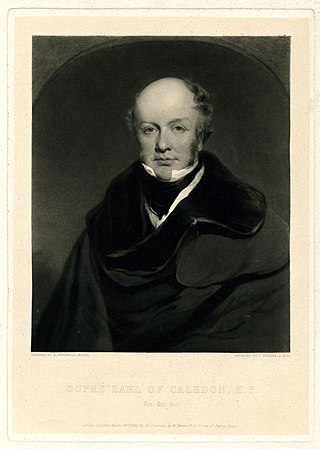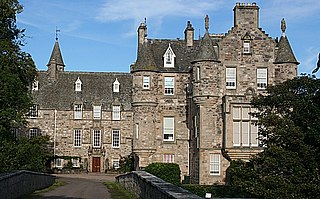
Balmoral Castle is a large estate house in Aberdeenshire, Scotland, and a residence of the British royal family. It is near the village of Crathie, 9 miles (14 km) west of Ballater and 50 miles (80 km) west of Aberdeen.

Castle Howard is a stately home in North Yorkshire, England, within the civil parish of Henderskelfe, located 15 miles (24 km) north of York. It is a private residence and has been the home of the Carlisle branch of the Howard family for more than 300 years. Castle Howard is not a fortified structure, but the term "castle" is sometimes used in the name of an English country house that was built on the site of a former castle.

Sophie, Duchess of Edinburgh, is a member of the British royal family. She is married to Prince Edward, Duke of Edinburgh, the youngest sibling of King Charles III.

Harewood House is a country house in Harewood, West Yorkshire, England. Designed by architects John Carr and Robert Adam, it was built, between 1759 and 1771, for Edwin Lascelles, 1st Baron Harewood, a wealthy West Indian plantation and slave-owner. The landscape was designed by Lancelot "Capability" Brown and spans 1,000 acres (400 ha) at Harewood.

Belvoir Castle is a faux historic castle and stately home in Leicestershire, England, situated 6 mi (10 km) west of the town of Grantham and 10 mi (16 km) northeast of Melton Mowbray. The Castle was first built immediately after the Norman Conquest of 1066 and has since been rebuilt at least three times, the surviving structure, a grade I listed mock castle, dating from the early 19th century. It is the seat of David Manners, 11th Duke of Rutland, whose direct male ancestor inherited it in 1508. The traditional burial place of the Manners family was in the parish church of St Mary the Virgin, Bottesford, situated 3 mi (5 km) to the north of the Castle, but since 1825 they have been buried in the ducal mausoleum built next to the Castle in that year, to which their ancient monuments were moved. It remains the private property of the Duke of Rutland but is open to the general public.

The Duchy of Lancaster is a private estate of the British sovereign. The estate has its origins in the lands held by the medieval Dukes of Lancaster, which came under the direct control of the monarch when Henry Bolingbroke, the then duke of Lancaster, ascended the throne in 1399. In 1461 King Edward IV confirmed that the duchy would be inherited by the monarch, but held separately from the Crown Estate, the other assets which belong to the monarch.

Portadown is a town in County Armagh, Northern Ireland. The town sits on the River Bann in the north of the county, about 24 mi (39 km) southwest of Belfast. It is in the Armagh City, Banbridge and Craigavon Borough Council area and had a population of about 21,097 at the 2021 Census. For some purposes, Portadown is treated as part of the "Craigavon Urban Area", alongside Craigavon and Lurgan.

Sirima Ratwatte Dias Bandaranaike, commonly known as Sirimavo Bandaranaike (මැතිනිය), was a Sri Lankan politician. She was the world's first female prime minister when she became Prime Minister of Sri Lanka in 1960. She chaired the Sri Lanka Freedom Party (SLFP) from 1960 to 1994 and served three terms as prime minister, two times as the chief executive, 1960 to 1965 and 1970 to 1977, and once again in a presidential system from 1994 to 2000, governing under the presidency of her daughter Chandrika Kumaratunga.

Earl of Caledon, of Caledon in the County of Tyrone, is a title in the Peerage of Ireland. It was created in 1800 for James Alexander, 1st Viscount Caledon. He was a merchant who had made an enormous fortune in India. He also represented the constituency of Londonderry City in the Irish House of Commons. Alexander had already been created Baron Caledon in 1790 and Viscount Caledon, of Caledon in the County of Tyrone, in 1797, also in the Peerage of Ireland. In 1784, James Alexander purchased a city house in Dublin at Rutland Square where he lived when serving as an MP for Derry.

Castle Coole is a townland and a late-18th-century neo-classical mansion situated in Enniskillen, County Fermanagh, Northern Ireland. Set in a 1,200-acre (490 ha) wooded estate, it is one of three properties owned and managed by the National Trust in County Fermanagh, the others being Florence Court and the Crom Estate.

Belfast Castle is a mansion located in Cave Hill Country Park in Belfast, Northern Ireland, in a prominent position 400 feet (120 m) above sea level. Its location provides unobstructed views over the City of Belfast and Belfast Lough. There have been several different structures called 'Belfast Castle' over the centuries, located on different sites. The current 'castle' is a Victorian structure, built between 1867 and 1870 on the slopes of Cave Hill, and is listed as being Grade B+. The main entrance into the Belfast Castle Demesne is now where Innisfayle Park meets Downview Park West, just off the Antrim Road. The original main entrance into the current demesne was formerly on the Antrim Road itself, where Strathmore Park now meets the Antrim Road.

Elvaston Castle is a stately home in Elvaston, Derbyshire, England. The Gothic Revival castle and surrounding parkland is run and owned by Derbyshire County Council as a country park known as Elvaston Castle Country Park. The country park has 200 acres (0.81 km2) of woodlands, parkland and formal gardens.

Stewartstown is a small town in County Tyrone, Northern Ireland, close to Lough Neagh and about 5 miles (8 km) from Cookstown, 3 miles (5 km) from Coalisland and 7 miles (11 km) from Dungannon. Established by Scottish Planters early in the 17th century, its population peaked before the Great Famine of the 1840s at over 1000. In the 2011 Census the town had a population of 650 people.

Du Pré Alexander, 2nd Earl of Caledon KP, styled The Honourable Du Pré Alexander from 1790 to 1800 and Viscount Alexander from 1800 to 1802, was an Irish peer, landlord and colonial administrator, and was the second child and only son of James Alexander, 1st Earl of Caledon.

Eric James Desmond Alexander, 5th Earl of Caledon was a soldier and the eldest son of James Alexander, 4th Earl of Caledon and his wife, Lady Elizabeth Graham-Toler.
Crom Castle is a country house on the shores of Upper Lough Erne in County Fermanagh, Northern Ireland, the seat of the Earls Erne. Standing within a 1,900-acre (7.7 km2) estate, and within a formal garden, the castle is built in stone. A central battlemented tower includes the main entrance, and there are also smaller towers to one side. It stands apart from the ruins of Old Crom Castle, of which two towers, some walls, and a ha-ha survive, and near them two ancient yew trees, believed to be at least 800 years old.
Peter Randolph Louis Beatty was an English racehorse owner and breeder, businessman and member of the aristocracy.
Charles William Cayzer, is a British businessman.

Cullen House is a large house, about 1 kilometre (0.6 mi) south-west of the coastal town of Cullen in Moray, Scotland. It was the seat of the Ogilvies of Findlater, who went on to become the Earls of Findlater and Seafield, and it remained in their family until 1982. Building work started on the house in 1600, incorporating some of the stonework of an earlier building on the site. The house has been extended and remodelled several times by prominent architects such as James Adam, John Adam, and David Bryce. It has been described by the architectural historian Charles McKean as "one of the grandest houses in Scotland" and is designated a Category A listed building. The grounds were enlarged in the 1820s when the entire village of Cullen, save for Cullen Old Church, was demolished to make way for improvements to the grounds by Lewis Grant-Ogilvy, 5th Earl of Seafield; a new village, closer to the coast, was constructed for the inhabitants. Within the grounds are a bridge, a rotunda and a gatehouse, each of which is individually listed as a Category A structure.

This article is intended to show a timeline of the history of Belfast, Northern Ireland, up to the present day.
















